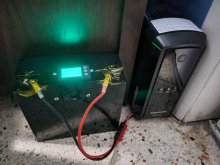Hi there,
I have a couple of UPS that are completly funcional but they dont have batteries.
Instead of buying Lead acid batteries I was thinking of making a LiFePO4 battery pack and use it instead of the lead acid batteries.
I have done some research but I do not have enough information yet so:
- I know that the UPS runs at 12V;
- From what I have read, it will cutoff as safety at 12.9V (2.15V per cell) and will consider a max charge at 14.1V (2.35V per cell);
- Is it safe to make a battery pack, connect it to a LiFePO4 BMS and put it inside? Will this simple conversion cause any problems in the future (to the battery)?
- Could the charging of the UPS hurt the batteries (from what I've read, both are charged via CC-CV ).
Although I know I wont take advantage of the full potential of the pack there is no problem. From what little I would lose it is still better that the original lead acid battery.
Thanks in advance
I have a couple of UPS that are completly funcional but they dont have batteries.
Instead of buying Lead acid batteries I was thinking of making a LiFePO4 battery pack and use it instead of the lead acid batteries.
I have done some research but I do not have enough information yet so:
- I know that the UPS runs at 12V;
- From what I have read, it will cutoff as safety at 12.9V (2.15V per cell) and will consider a max charge at 14.1V (2.35V per cell);
- Is it safe to make a battery pack, connect it to a LiFePO4 BMS and put it inside? Will this simple conversion cause any problems in the future (to the battery)?
- Could the charging of the UPS hurt the batteries (from what I've read, both are charged via CC-CV ).
Although I know I wont take advantage of the full potential of the pack there is no problem. From what little I would lose it is still better that the original lead acid battery.
Thanks in advance



